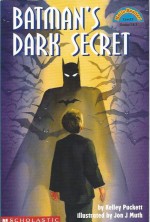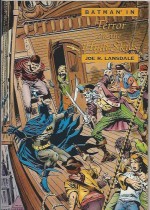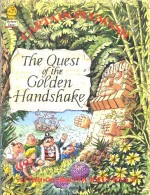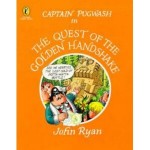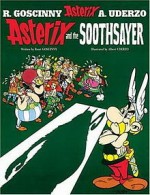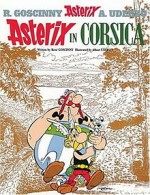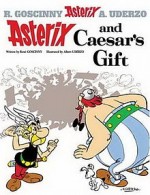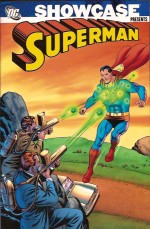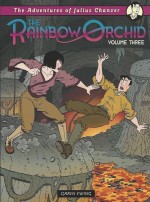
By Garen Ewing (Egmont UK)
ISBN: 978-1-4052-5599-8
Plucky True Brit Julius Chancer and his fellow daredevil travellers began popping up around 2003 in self-published mini-comics and small press publications – I wish there was a less loaded or pejorative term for magazines produced by devoted, if unpaid, creators – before migrating online (see www.rainboworchid.co.uk) to rapturous praise from industry and public alike.
Tintin publisher Egmont sagaciously picked up the series and in 2009 released the first part of the rousing trilogy which fabulously referenced old world fantasy romances for this new yarn of gripping globe-girdling, treasure-seeking derring-do, which has quickly become a notable addition to the ranks of magnificent all-ages full-colour adventure albums.
Splendidly extending the appeal of period dramas and classic adventures tales such as Rider Haggard’s safari sagas and Conan Doyle’s Professor Challenger stories, and set in the fabled and fabulous Roaring Twenties, the first two books of the trilogy detailed how Chancer, young but capable assistant to renowned historical researcher and gentleman breeder of orchids Sir Alfred Catesby-Grey, undertook a mission to the wilds of the East in search of a legendary bloom mentioned in legends dating back to Alexander the Great.
Sir Alfred had been approached by Lord Reginald Lawrence, scion of an ancient and noble house, who was duped into an impossible wager by repellent entrepreneur Urkaz Grope. At stake was the “Trembling Sword of Tybalt Stoneâ€; a priceless antique and the seat of the family’s honour since 1445, without which Lord Lawrence would have to surrender all his estates and titles…
To win the wager Lawrence needed an example of Iriode Orchino or the rainbow orchid, a mythical bloom last seen by Alexander over two thousand years ago. Although Catesby-Grey initially pooh-poohed the whole story, Julius was keen to investigate, perhaps as tempted by the prospect of adventure and a large fee as by the urgings of plucky Lady Lily, Lawrence’s daughter and a silent film actress recently returned from Hollywood to the heart of the Empire.
Grope had a highly secret agenda of his own and no principles at all, whilst the vulgarly intrusive journalist William Pickle had no scruples and definitely no fear as he sniffed out news and controversy like an obsessed bloodhound.
Moreover Lily’s Movie Publicity Agent Nathaniel Crumpole always seemed in the thick of whatever trouble was brewing – could even an American be that determinedly naive?
Chancer determined to risk all in tracking down the orchid and, despite a series of viciously calculated ploys by Grope and his gang of cutthroats, set off with Lily and Crumpole for Karachi and the fantastic flower’s last reported whereabouts…
Catesby-Grey once ran a very hush-hush government artefact-hunting department dubbed the Empire Survey Branch, but that ultra-discreet body had fallen upon hard times. When he pursued some enquires amongst his old clandestine colleagues, Sir Alfred found that lack of funding had placed them under the aegis of the military and twisted their working philosophy into a rabid hunt for ancient weapons of mass destruction…
After some deadly clashes with Grope’s murderous fixer Evelyn Crow and her hired thugs, Julius, Lily, Crumpole and pilot Benoit Tayaut reached India, narrowly escaping blazing doom as their aeroplane crashed. Rendezvousing with British Civil Servant Major Fraser-Tipping the explorers began the next stage of their trek with Crow and cronies in hot pursuit…
In England, Pickle, who had first broken the story of the orchid wager, was taken prisoner by an influential and affluent secret society, although his newshound colleague George Scrubbs diligently stayed on his trail whilst Grope’s plans to bully and buy his way into the upper echelons of English Society proceeded apace.
In India, after another brutal attack by Crow’s goons, the voyagers found an ally in Meru, manservant of incredibly aged missionary Father Pinkleton who claimed to have seen an actual rainbow orchid.
Heading into the wastes of Hasan Wahan, Julius and his enlarged party were unaware that they had a traitor in their group. After making one more incredibly lucky and fantastic discovery and nearing the end of their quest, Crow launched another murderous assault and one of our plucky heroes seemingly plunged to his death…
This final instalment opens with the survivors of Chancer’s party recuperating in a native village, when Crumpole – who hadn’t fallen far after hurtling over a cliff – wanders in, accompanied by Sir Alfred and Mr. Drubbin, an agent of the Empire Survey Branch. The pair have rushed to Asia in a desperate hope of finding something valuable enough to save the ESB from closure…
They are stalked by the remorseless Crow who, despite her wounds, is obsessively determined to complete her mission at all costs…
Following Pinkleton’s map the united expedition trudges off into the wilds and eventually reaches the mountainous region of Uskandagadri, from whence Meru originated years before. Drubbin then informs the explorers that they are being followed. Lying in wait, Chancer and Drubbin ambush and capture Crow as in England, Scrubbs – with the grudging assistance of Grope’s disgraced and discharged botanist Newton – infiltrates a meeting of the Black Lion secret society in a disastrous attempt to rescue Pickle and fellow prisoner Eloise Tayaut …
After seven days in the mountains, Chancer’s party find millennial clues left by Alexander and then stumble into a terrifying whirlpool before fortuitously washing up in a lost land of fantastic creatures and small levitating castles.
Unfortunately the warriors manning the flying fort recognise Meru and it’s clear that he is far from welcome…
Once the tragic hidden history of Meru and the incredibly ancient, super-scientific lost kingdom comes out, the explorers decide to escape but become embroiled in unrest caused by Meru’s return. Moreover, Evelyn is still trying to murder Julius. Drubbin, with an agenda of his own, takes the opportunity to pilfer knowledge and weapons from the city’s Great Library – secrets which caused the ultimate destruction of the magnificent civilisation eons ago…
As the explorers flee through subterranean caverns, Julius finally finds the rare bloom he’s been searching for and clashes with Crow one last time.
With the deadline for the wager fast-approaching and the Trembling Sword of Tybalt Stone seemingly lost to Lily and her father, the adventurers pile aboard a flying keep and head for Britain, unaware of the full scope of Grope’s plans.
Luckily Julius picked up a vital scrap of information in his climactic duel with Crow and after crashing to Earth at the British Empire Exhibition – and the moment of Grope’s ultimate triumph – delivers a nasty surprise which completely scuppers the monstrous usurper and resoundingly saves the day…
Enchanting, beguiling, astonishingly authentic and masterfully illustrated in the seductive Ligne Claire style, Garen Ewing’s stunning pastiche of the genre pioneered by Hergé and E.P. Jacobs places this magical yarn amongst the very best of graphic narratives, and in these books he has managed to synthesise something vibrant, vital, fresh and uniquely entertaining for modern readers of all ages.
Pure comics mastery – and where else could you get hot, fresh, thrill-a-minute nostalgia, just like your granddad used to love?
I can’t wait for more – and isn’t that the best test of a perfect book?
© 2012 Garen Ewing. All Rights Reserved.


